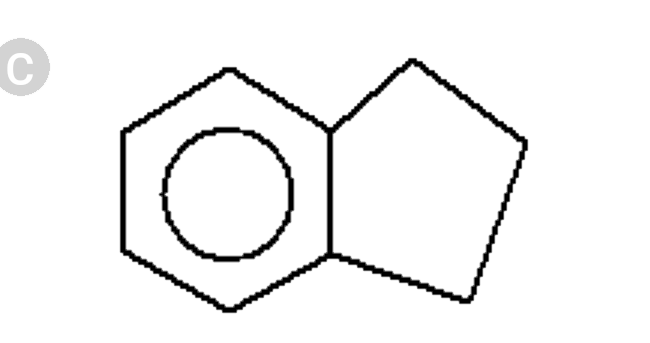Consider the following sequence of reactions and identify the final product (Z) C6H6+CH2=CHCH2ClAlCl2−−→(X)(i)BH3,THF−−−−−−−−−−→(ii)H2O2,OH−(Y)H+/Δ−−−−→Z(C9H10)
PhCH2CH=CH2
PhCH=CH−CH3

PhC(CH3)=CH2
The correct Answer is:C
To solve the problem step by step, let's break down the sequence of reactions:
Step 1: Electrophilic Substitution Reaction
1. Starting Material: Benzene (C₆H₆) is reacted with allyl chloride (CH₂=CHCH₂Cl) in the presence of a Lewis acid, AlCl₃.
2. Mechanism: The Lewis acid (AlCl₃) activates the allyl chloride, generating a more reactive electrophile (the allyl cation). Benzene undergoes electrophilic substitution, where the electrophile attacks the benzene ring.
3. Product (X): The product of this reaction will be allylbenzene (C₆H₅-CH₂-CH=CH₂).
Step 2: Hydroboration-Oxidation
1. Reagents: The product (X) is treated with BH₃ in tetrahydrofuran (THF), followed by H₂O₂ in the presence of OH⁻.
2. Hydroboration: BH₃ adds across the double bond of the allyl group. The hydrogen adds to the less substituted carbon, and the boron adds to the more substituted carbon, leading to the formation of a trialkylborane.
3. Oxidation: The subsequent treatment with H₂O₂ and OH⁻ converts the boron to an alcohol. This results in the formation of an alcohol with the structure: C₆H₅-CH₂-CH₂-CH₂OH (which we will call Y).
Step 3: Protonation and Carbocation Formation
1. Protonation: The alcohol (Y) is treated with an acid (H⁺), which protonates the hydroxyl group, making it a better leaving group.
2. Carbocation Formation: The water molecule leaves, forming a carbocation at the end of the alkyl chain (C₆H₅-CH₂-CH₂-CH₂⁺).
Step 4: Electrophilic Substitution Again
1. Electrophilic Attack: The carbocation can now act as an electrophile and will react with the benzene ring through another electrophilic substitution, forming a new carbon-carbon bond.
2. Product Formation: This leads to a new product that contains a five-membered ring structure attached to the benzene.
Step 5: Final Heating Step
1. Heating: When the product is heated, a rearrangement occurs, leading to the loss of a hydrogen atom from the five-membered ring.
2. Final Product (Z): The final product Z is a compound where the benzene ring is now fused to a five-membered ring, which corresponds to the structure of a bicyclic compound.
Final Product
The final product Z is thus a bicyclic compound formed from the fusion of the benzene ring and the five-membered ring structure.
Summary of Final Product
- Final Product (Z): The final product Z is a bicyclic compound formed from benzene and a five-membered ring, which corresponds to option number 3 in the given choices.
1. Starting Material: Benzene (C₆H₆) is reacted with allyl chloride (CH₂=CHCH₂Cl) in the presence of a Lewis acid, AlCl₃.
2. Mechanism: The Lewis acid (AlCl₃) activates the allyl chloride, generating a more reactive electrophile (the allyl cation). Benzene undergoes electrophilic substitution, where the electrophile attacks the benzene ring.
3. Product (X): The product of this reaction will be allylbenzene (C₆H₅-CH₂-CH=CH₂).
1. Reagents: The product (X) is treated with BH₃ in tetrahydrofuran (THF), followed by H₂O₂ in the presence of OH⁻.
2. Hydroboration: BH₃ adds across the double bond of the allyl group. The hydrogen adds to the less substituted carbon, and the boron adds to the more substituted carbon, leading to the formation of a trialkylborane.
3. Oxidation: The subsequent treatment with H₂O₂ and OH⁻ converts the boron to an alcohol. This results in the formation of an alcohol with the structure: C₆H₅-CH₂-CH₂-CH₂OH (which we will call Y).
1. Protonation: The alcohol (Y) is treated with an acid (H⁺), which protonates the hydroxyl group, making it a better leaving group.
2. Carbocation Formation: The water molecule leaves, forming a carbocation at the end of the alkyl chain (C₆H₅-CH₂-CH₂-CH₂⁺).
1. Electrophilic Attack: The carbocation can now act as an electrophile and will react with the benzene ring through another electrophilic substitution, forming a new carbon-carbon bond.
2. Product Formation: This leads to a new product that contains a five-membered ring structure attached to the benzene.
1. Heating: When the product is heated, a rearrangement occurs, leading to the loss of a hydrogen atom from the five-membered ring.
2. Final Product (Z): The final product Z is a compound where the benzene ring is now fused to a five-membered ring, which corresponds to the structure of a bicyclic compound.
The final product Z is thus a bicyclic compound formed from the fusion of the benzene ring and the five-membered ring structure.
- Final Product (Z): The final product Z is a bicyclic compound formed from benzene and a five-membered ring, which corresponds to option number 3 in the given choices.
Topper's Solved these Questions
Similar Questions
Knowledge Check
The product (z) in the following sequence of reaction is
C6H6+CH2=CHCH2ClAlCl3−−→(X)(i) BH3/THF−−−−−−−−−−→(ii) H2O2,OH(j)HF−−→heatC9H10(z)A B
B C
C Dnone of the above
Dnone of the aboveIdentify the final product in that follow sequence of reactions.
CH2=CH2Br2−−→(X)KCN−−→(Y)H3O+−−−→(Z)ACH3BrCH2COOHBHOOCCH2COOHCHOOCCH2CH2COOHDHOOCCH(CH3)COOHWhat is product of the following sequence of reactions ?
(CH3)2C=CHCH2CH3(i)BH3/THF−−−−−−−−−−→(ii)H2O2,OH−PCC−−−−→CH2Cl2(i)CH3MgBr−−−−−−−−→(ii)H3O+A2, 4 - dimethyl - 3- pentanolB2, 3 - dimethyl - 3- pentanolC2, 3 - dimethyl - 2- pentanolD2, 2 - dimethyl - 3 - pentanol
The final product of the following sequence of reaction is :
(CH3O)2CHCH2CH2CH2BrMg−−→H2C=O−−−−→H3O+−−−−−−→heat
View SolutionIn the following sequence of reactions, the final product is
C6H61.Br2/Fe−−−−−−−→2.Mg/ether(I)HCHO−−−→(II)Cl2/Fe−−−−→(III)CrO3−−−−→Pyridine(IV)
View SolutionConsider the following sequence of reactions
C2H5C≡CHCH3MgBr−−−−−→A(1)HCHO−−−−−−→(2)H2O+B
The product (B) is
View SolutionConsider the following sequence of reactions.
C6H6+CH3CH=CH2H3PO4−−−→heatA1.O2,heat−−−−−→2.H3O+B+C
The products (B) and (C) are:
View SolutionWhat is the final product of the reaction?
(CH3)2=CHCH2CH3(i)BH3/THF−−−−−−−−→PC−−→(i)CH3MgBr−−−−−−−−−−→(ii)H2O+
View Solution
